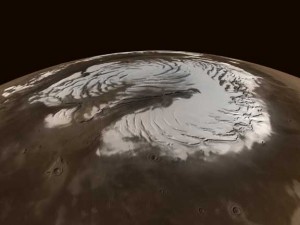MONDAY, 11 OCTOBER 2010
Seasonal Martian ice sheets can be up to a metre thick, and are deposited alternately in northern and southern winter. These deposits are mainly composed of carbon dioxide with minor quantities of water, dust and sublimate when the temperature rises in the spring, thus becoming a major source of water vapour in the Martian atmosphere.Recent observations of Martian ice have suggested a peculiar disappearance of CO2 ice in certain regions of the planet. Researchers observed that the diagnostic signature of carbon dioxide ice vanished even though the surface temperature was not warm enough to sublimate CO2. It has now been suggested that this is due to water ice covering the carbon dioxide, since the solar radiation would have been great enough to only sublimate the CO2 in the surface layer of ice, and not the water. This, in turn, forms a thin layer of pure water ice which masks the CO2 beneath it from surface observation.
In Gemina Lingula, a Northern plateau, this hypothesis was further corroborated when researchers found that the carbon dioxide signature reappeared when the temperature was again warm enough to vaporise the surface water layer. In a trough region of the northern permanent ice cap, however, the carbon dioxide ice reappeared very quickly after its initial disappearance. This has previously baffled scientists as the temperature was neither warm enough to vaporise the water, nor cold enough to re-condense the surface layer of carbon dioxide. A model has now been used to show that katabatic (downhill) winds, common in the area due to its topography, are capable of physically removing the surface layer of water ice, revealing the CO2 below.
The results were presented at the European Planetary Science Congress.
Written by Katy Wei

